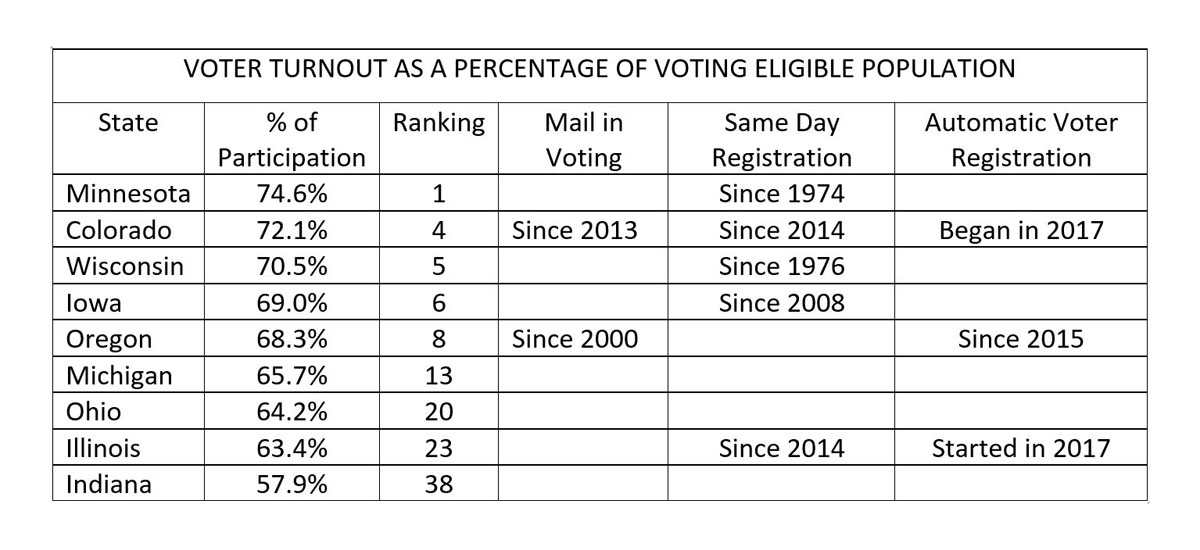 Voter turnout is a concern across the country, but it’s especially concerning in Indiana. It’s been low in Indiana for years, but it hit rock bottom in 2014 when, by many measures, Indiana had the lowest voter turnout of all the states. By the 2016 Presidential elections, there was improvement, but Indiana was still rated as 38th out of the 50 states, with 59.7% of registered voters casting ballots.
Voter turnout is a concern across the country, but it’s especially concerning in Indiana. It’s been low in Indiana for years, but it hit rock bottom in 2014 when, by many measures, Indiana had the lowest voter turnout of all the states. By the 2016 Presidential elections, there was improvement, but Indiana was still rated as 38th out of the 50 states, with 59.7% of registered voters casting ballots.
Why should that be? I compared Indiana’s 2016 performance with six other states that had better results to try to understand why Indiana’s performance has been fair to poor.
 The best analysis I’ve seen suggests that voter turnout is negatively influenced by three factors:
The best analysis I’ve seen suggests that voter turnout is negatively influenced by three factors:
-
Barriers to voter registration. Two solutions seem to have promise:
- Same Day Registration (SDR) The six highest ranking states all have same day voter registration which allows voters to register or fix a registration issue when they vote. States using SDR have averaged seven points higher in voter turnout than states without it. Minnesota has been number one in turnout for 8 out of the last 9 presidential elections.
- Automatic Voter Registration (AVR). Oregon was the first state to automatically register eligible citizens who have driver’s licenses (except those who decline). The state has already seen significant registration increases since implementing the policy in January 2016. In 2017, Indiana took a rather tentative step toward encouraging voter registration by providing that that when individuals transact business with a license branch (other than for a motor vehicle driver's license, permit, or identification card) they must be asked if they want to register to vote or change their voter registration record. If so, they are given a paper voter registration application form they must file with the county voter registration office.
- Inconvenience of Voting. Although early voting and relaxed requirements for absentee voting have provided alternatives to a requirement that voters accommodate to rigid voting schedules on election day, it appears that additional efforts might significantly improve turnout. Three states with the highest voter turnout—Oregon, Washington and Colorado—have adopted vote-by-mail approaches that have received high marks by voters and election administrators alike. Every registered voter receives their ballot 2 to 3 weeks prior to the election and may return it by mail or at a local drop box. Colorado also maintains vote centers for those who prefer to vote in person.
-
Lack of Competitive Races. Joseph Losco, who heads the Bowen Center for Public Affairs at Ball State University, says that the heart of Indiana’s poor voter turnout is the lack of competitive elections. In 2014, 43% of the Indiana House and Senate races were uncontested in the general election. The Cook Political Report rated only 37 of 435 U.S. House races as competitive on the eve of the 2016 election. Two factors seem central to this issue:
- Gerrymandering, which results in legislative and congressional districts that are designed to protect incumbents rather than represent the electorate.
- Lack of qualified candidates, resulting in uncontested positions or landslide victories which suggest the futility of voting. Many qualified persons don’t seek office because of disdain for the hyper partisanship and character assassination that pervades many races as well as the cost—both financial and personal involved with candidacy.
Improving voter turnout in Indiana isn’t about the outcome of any specific election, or about helping Democrats or Republicans. We need to find better tools and methods to make the case to all eligible citizens that voting matters, even when it won’t change the outcome of an election. We shouldn’t settle for being dead last in voter turnout (2014) or even 38th out of 50 (2016).